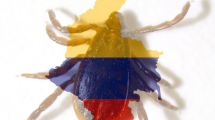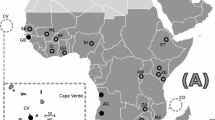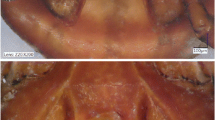Abstract
Brown dog ticks morphologically identifiable as Rhipicephalus sanguineus sensu lato, are distributed world-wide and their systematics is controversial. Results of genetic and reproductive compatibility studies of geographically distinct populations of R. sanguineus s.l. indicate that the R. sanguineus complex is paraphyletic. To further elucidate systematic relationships within R. sanguineus s.l. and geographic boundaries of its lineages, we conducted a phylogeographical study of 136 tick specimens from 23 countries. Voucher specimens were morphologically identified. A phylogenetic tree was constructed using concatenated partial mitochondrial 12S and 16S rDNA gene sequences and analyzed by the Neighbor-Joining method. A set of 19 bioclimatic variables within the WorldClim dataset were extracted and analyzed to assess correlations between distribution of R. sanguineus s.l. lineages and climatic variables. The following four branches are clearly recognized on the phylogenetic tree: R. sanguineus s.l.—tropical and temperate clades, R. leporis, and R. turanicus. DNA sequences of Rhipicephalus ticks from Israel differ from those of other groups. Strong association between geographical locations of major clades of R. sanguineus s.l. and temperature was identified. The tropical clade of R. sanguineus s.l. occupies areas with the annual mean temperature >20 °C, whereas the temperate clade is present in areas with the annual mean temperature <20 °C. Our results indicate that ticks in two closely related phylogenetic clades are adapted to different environmental conditions and support proposals for re-classification of R. sanguineus complex. Differences in R. sanguineus s.l. ecology and human/animal pathogens transmitted by different taxa of brown dog tick need to be studied.


Similar content being viewed by others
References
Barandika JF, Olmeda SA, Casado-Nistal MA, Hurtado A, Juste RA, Valcárcel F, Anda P, García-Pérez AL (2011) Differences in questing tick species distribution between Atlantic and continental climate regions in Spain. J Med Entomol 48(1):13–19
Beati L, Keirans JE (2001) Analysis of the systematic relationships among ticks of the genera Rhipicephalus and Boophilus (Acari: Ixodidae) based on mitochondrial 12S ribosomal DNA gene sequences and morphological characters. J Parasitol 87:32–48
Burlini L, Teixeira KR, Szabó MP, Famadas KM (2010) Molecular dissimilarities of Rhipicephalus sanguineus (Acari: Ixodidae) in Brazil and its relation with samples throughout the world: Is there a geographical pattern? Exp Appl Acarol 50:361–374
Dantas-Torres F, Otranto D (2015) Further thoughts on the taxonomy and vector role of Rhipicephalus sanguineus group ticks. Vet Parasitol 208(1–2):9–13. doi:10.1016/j.vetpar.2014.12.014
Dantas-Torres F, Chomel BB, Otranto D (2012) Ticks and tick-borne diseases: a One Health perspective. Trends Parasitol 28:437–446
Dantas-Torres F, Latrofa MS, Annoscia G, Gianelli A, Parisi A, Otranto D (2013) Morphological and genetic diversity of Rhipicephalus sanguineus sensu lato from the New and Old Worlds. Parasites Vectors 6:213
Eremeeva ME, Dasch GA (2009) Closing the gaps between genotype and phenotype in Rickettsia rickettsii. Ann N Y Acad Sci 1166:12–26. doi:10.1111/j.1749-6632.2009.04526.x
Eremeeva ME, Zambrano ML, Anaya L, Beati L, Karpathy SE, Santos-Silva MM, Salceda B, MacBeth D, Olguin H, Dasch GA, Aranda CA (2011) Rickettsia rickettsii in Rhipicephalus ticks, Mexicali, Mexico. J Med Entomol 48:418–421
Feldman-Muhsam B (1952) On the identity of Rhipicephalus sanguineus Lat. Bull Res Counc Israel 2:187–194
Felsenstein J (1985) Confidence limits on phylogenies: an approach using the bootstrap. Evolution 39:783–791
Filippova NA (1997) Fauna of Russia and neighboring countries. Ixodid ticks of subfamily Amblyomminae. Nauka Publishing House, Moscow. ISBN 5-02-026081-9
Gray J, Dantas-Torres F, Estrada-Peña A, Levin M (2013) Systematics and ecology of the brown dog tick, Rhipicephalus sanguineus. Ticks Tick Borne Dis 4:171–180
Hoogstraal H (1956) African Ixodoidea. I. Ticks of the Sudan (with special reference to Equatoria Province and with preliminary reviews of the Genera Boophilus, Margaropus, and Hyalomma. Dept. of the Navy, Bureau of Medicine and Surgery, Washington, DC
Karpathy SE, Dasch GA, Eremeeva ME (2007) Molecular typing of isolates of Rickettsia rickettsii by use of DNA sequencing of variable intergenic regions. J Clin Microbiol 45(8):2545–2553
Latreille PA (1809) Genera crustaceorum et insectorum: secundum ordinem naturalem in familias disposita, iconibus exemplisque plurimis explicata. Amand Koenig, bibliopolam, Parisiis et Argentorati
Levin ML, Studer E, Killmaster L, Zemtsova G, Mumcuoglu KY (2012) Crossbreeding between different geographical populations of the brown dog tick, Rhipicephalus sanguineus (Acari: Ixodidae). Exp Appl Acarol 58:51–68
Liu GH, Chen YZ, Song HQ, Lin RQ, Zhou DH, Zhu XQ (2013) Complete mitochondrial genome sequence data provides evidence that dog tick Rhipicephalus sanguineus (Acari: Ixodidae) represents a species complex. Int J Biol Sci 9:361–369
Mangold AJ, Bargues MD, Mas-Coma S (1998) Mitochondrial 16S rDNA sequences and phylogenetic relationships of species of Rhipicephalus and other tick genera among Metastriata (Acari: Ixodidae). Parasitol Res 84:478–484
Moraes-Filho J, Marcili A, Nieri-Bastos FA, Richtzenhain LJ, Labruna MB (2011) Genetic analysis of ticks belonging to the Rhipicephalus sanguineus group in Latin America. Acta Trop 117:51–55
Moraes-Filho J, Krawczak FS, Costa FB, Soares JF, Labruna MB (2015) Comparative evaluation of the vector competence of four south American Populations of the Rhipicephalus sanguineus Group for the Bacterium Ehrlichia canis, the agent of canine monocytic ehrlichiosis. PLoS ONE 10(9):e0139386
Morel PC, Vassiliades G (1963) Les Rhipicephalus du groupe sanguineus: espéces Africaines (Acariens: Ixodoidea). Rev Elev Med Vet Pay 15:343–386
Nava S, Estrada-Peña A, Petney T, Beati L, Labruna MB, Szabó MP, Venzal JM, Mastropaolo M, Mangold AJ (1806) Guglielmone AA (2015) The taxonomic status of Rhipicephalus sanguineus (Latreille. Vet Parasitol 208(1–2):2–8. doi:10.1016/j.vetpar.2014.12.021
Nava S, Mastropaolo M, Venzal JM, Mangold AJ, Guglielmone AA (2012) Mitochondrial DNA analysis of Rhipicephalus sanguineus sensu lato (Acari: Ixodidae) in the southern cone of South America. Vet Parasitol 190:547–555
Neumann LG (1911) Ixodidae in “Das Tierreich”, herausg. v. T.E. Schulze, im Auftrage der K. Preuss. Akad d. Wiss. zu Berlin, 26. R. Friedländer & Sohn, Berlin
Oliveira PR, Bechara GH, Denardi SE, Saito KC, Nunes ET, Szabó MP, Mathias MI (2005) Comparison of the external morphology of Rhipicephalus sanguineus (Latreille, 1806) (Acari: Ixodidae) ticks from Brazil and Argentina. Vet Parasitol 129(2005):139–147
Paddock CD, Denison AM, Lash RR, Liu L, Bollweg BC, Dahlgren FS, Kanamura CT, Angerami RN, Pereira dos Santos FC, Brasil Martines R, Karpathy SE (2014) Phylogeography of Rickettsia rickettsii genotypes associated with fatal Rocky Mountain spotted fever. Am J Trop Med Hyg 91(3):589–597. doi:10.4269/ajtmh.14-0146
Pegram RG, Keirans JE, Clifford CM, Walker JB (1987) Clarification of the Rhipicephalus sanguineus group (Acari, Ixodoidea, Ixodidae). II. R. sanguineus (Latreille, 1806) and related species. Syst Parasitol 10:27–44
Saitou N, Nei M (1987) The neighbor-joining method: a new method for reconstructing phylogenetic trees. Mol Biol Evol 4:406–425
Szabó MP, Mangold AJ, Joao CF, Bechara GH, Guglielmone AA (2005) Biological and DNA evidence of two dissimilar populations of the Rhipicephalus sanguineus tick group (Acari: Ixodidae) in South America. Vet Parasitol 130:131–140
Tamura K, Dudley J, Nei M, Kumar S (2007) MEGA4: molecular evolutionary genetics analysis (MEGA) software version 4.0. Mol Biol Evol 24:1596–1599
Troughton DR, Levin ML (2007) Life cycles of seven ixodid tick species (Acari: Ixodidae) under standardized laboratory conditions. J Med Entomol 44:732–740
Walker JB, Keirans J, Horak IG (2000) The genus Rhipicephalus (Acari, Ixodidae): a guide to the brown ticks of the world. Cambridge University Press, Cambridge
Zumpt F (1939) Die Rhipicephalus-Arten der USSR, ein Beitrag zur Variabilitat in der Sanguineus-Gruppe. I. Vorstudie zu einer Revision der Gattung Rhipicephalus Koch. Z Parasitenkd 11:400–409
Zumpt F (1940) Zur Kenntnis der ausserafrikanischen Rhipicephalus-Arten. II. Vorstudie einer Revision der Gattung Rhipicephalus Koch. Z Parasitenkd 11:669–678
Acknowledgements
Authors are grateful to all partners: Marcos R. André, Lidia Chitimia, Gregory Dasch, Gerhard Dobler, Phil Kaufman, Marcelo Labruna, Amanda D. Loftis, Rosangela Zacarias Machado, Cheryl Magnusson, Alice Maina, Magalie Rene-Martellet, Melissa Miller, Andrew J. Monaghan, Santiago Nava, Christopher Paddock, Agustín Estrada-Peña, Frederic Stachurski, Holly Tuten, Alan Walker, Emma Weeks, and Nancy Velde who generously provided tick specimens.
Author information
Authors and Affiliations
Corresponding author
Additional information
Disclaimer:The views expressed in this article are those of the authors and do not necessarily reflect the official policy or position of the Air Force, the Department of Defense, Department of Health and Human Services, or the U.S. Government.
Rights and permissions
About this article
Cite this article
Zemtsova, G.E., Apanaskevich, D.A., Reeves, W.K. et al. Phylogeography of Rhipicephalus sanguineus sensu lato and its relationships with climatic factors. Exp Appl Acarol 69, 191–203 (2016). https://doi.org/10.1007/s10493-016-0035-4
Received:
Accepted:
Published:
Issue Date:
DOI: https://doi.org/10.1007/s10493-016-0035-4




